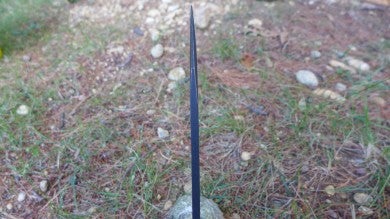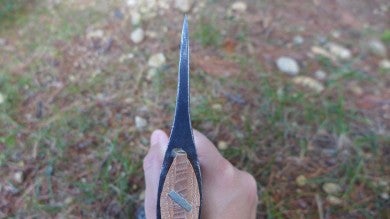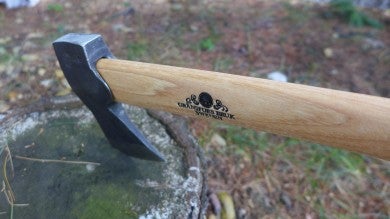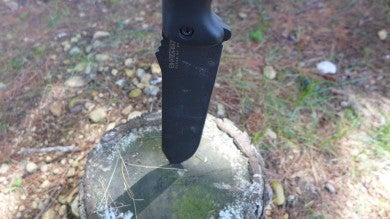A Newb’s Take on Chopper v. Hatchet, Part II
Tony Sculimbrene 11.03.14
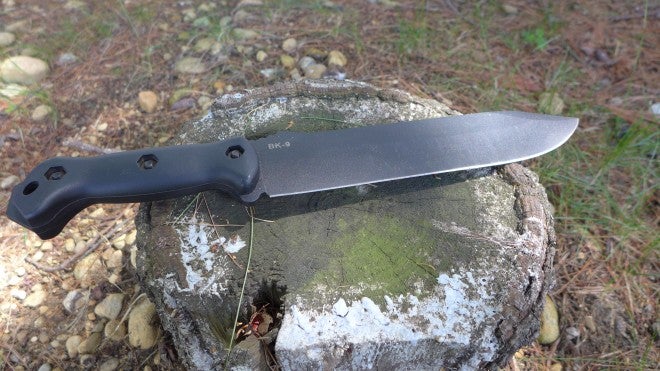
In the first part of this series, I laid out why I’m comparing these two items and went through what to avoid. And the Lesson #1 was that whatever tool you choose, it’s all about your skills. Now we get to the meat of the debate–the big things to look out for and be aware of when comparing a chopper and a hatchet.
Lesson #2: Blade Geometry Matters More Than Steel
The hatchet is going to perform differently than the chopper. Even in the modern era where we are “treated” to choppers that are a quarter inch or thicker, they do not have nearly the size of a hatchet.
A hatchet with a good convex grind is less likely to get stuck than a chopper and can, using good technique, pop open a piece of wood with much less effort and time. In the chopper v. hatchet debate, especially for a newb, geometry really, really matters.
But here is what I have learned: if you know about the differences in cutting edge geometry, you can overcome inferior steel. 1095 is great, but M4 it is not. That said, many a good chopper is made of 1095 because in this task it is geometry and not chemistry that really matters. It’s not that the steel doesn’t matter at all (I would, for example avoid 440A or 440B), but 1095 is a cheap default steel and it works well in this role.
But this brings up the second issue: the hatchet’s geometry is probably better for felling and delimbing than the chopper. No matter how thick the chopper is (Scrapyard knives released a 1/3 inch thick blade about 18 months ago), it’s not as thick as a hatchet. Some of the beefier knives from Bark River look capable thanks to their convex grind, but even they can’t hang with a Gransfors Bruks.
The BK-9
versus:
One last point about cutting geometry: the hatchet is much less prone to getting stuck. Any cutting tool can get stuck doing splitting work, but a hatchet is much less likely to be permanently embedded when simply chopping down or chopping apart a tree.
The comparatively thin edge of the chopper, in contrast, is more likely to get stuck, and this has safety implications. Many people have been injured trying to pull a stuck cutting tool out of a piece of wood.
Lesson #3: Where You Are and What You’re Cutting Matters
Traditionally, in places where there is green and not woody material, large thin knives like the machete or bolo have been used. These knives need reach and there is little to pound or split–just lots and lots of chopping. In other climates, like in North America, where there’s a lot of woody material, hatchets and axes have historically been much more useful. In the forests of North America you’re much more likely to need to fell an oak tree than you are to chop a path through the jungle. Under those circumstances, a machete would probably break well before the stout tree would.
But a chopper is not really the same thing as a machete or bolo. The latter are typically smaller and have much thicker blades (instead of 1/8″ we are looking at 3/16″ to 1/4″ of an inch). They are more like a traditional parang or kukri, both of which were large and thick. So this half breed knife is what we are comparing (I used the excellent BK-9 for these articles).
Lots of the wood processing I do is close to my house. About a quarter to half mile away there is a wooded area cleared about 50 years ago when railroad tracks were built. In the years since it has become dominated by maple trees, and these make superb firewood (and hiking sticks). Some of the trees are pretty thick, around the size of my waste, but a large number are around the size of my leg. In this very green wood, the chopper does quite fine. The bigger the tree, the harder it is on my hand and shoulder.
But when I am looking at larger trees, usually pine or in a rare case hickory, the chopper starts to fail. It binds in the thick, sticky wood of the pine trees and virtually glances off the hickory (to be fair, just about everything glances off hickory). In chopping down one of the small hickory trees, the chopper was just about useless. I couldn’t generate enough force to make it really bite, and the small nicks it produced were never going to make it through the iron-like wood. Even the hatchet had a tough time, but I was eventually able to get it through. This is clearly something that needed a full sized axe. Mind you this wasn’t a question of sharpness. I keep the BK-9 very sharp and the GB hatchet had the factory edge and was less than a month old. It’s just a matter of physics. Without the heft and concentrated cutting edge of a hatchet, the hickory was all but invulnerable.
If you are cutting down trees the size of a man’s leg or smaller, both will do fine, though I prefer the control of a chopper over the wild swinging power of a hatchet. If you are doing something bigger or something harder than green maple (which isn’t too bad, though it gets tough when it is dry), then you’ll be stymied by the chopper and beg for a hatchet or axe.
Lesson #4: Consider How You Like to Work
The utility of batonning is hotly debated on the Internet. Its function as a test of a chopper’s heft, design, and durability is compelling, but a lot of people think that it is useless as a fire building technique. Personally, I have found it very useful, allowing me to bridge the gap between twigs and logs in the my fire construction. I am also not able to process large trees, so I don’t need to fell these giants. Most of my work comes from processing large branches and small trees around my house (I hate throwing oak and maple away when we have a nice fireplace and cold New England winters).
In these instances the chopper works quite well. I’d give the edge to the hatchet in actually chopping stuff down and delimbing. The ability to do more detail work and actually split wood (yes, via batonning) makes me favor a chopper in my work. But the key here is what I am doing. If I happened to live in a more rural place, I could easily see the hatchet taking the fore, playing a complementary role to either a larger axe or a chainsaw. But as it is, the chopper works well given what I am doing.
There is, of course, the concern that I am letting tools dictate the work. When you don’t have a truck there are all sorts of things you don’t even consider doing. You’d never bother to pick up mulch yourself if you only had a car and an SUV, but with a truck you can go get a bed full of mulch and save a ton of money. A truck lets you change not only how you work, but what you consider doing. And given how much of a newb I am, I am perfectly willing to concede that I have not properly rethought what I can do with a hatchet and basically forced into tasks that I use a chopper for. Maybe as time moves on I will change my perspective, but for now, I like the chopper better given my work.
Next up, the final point of comparison and my conclusions on which I like better and why.
